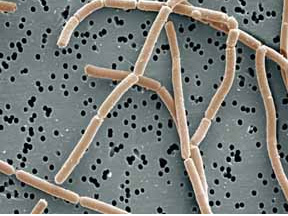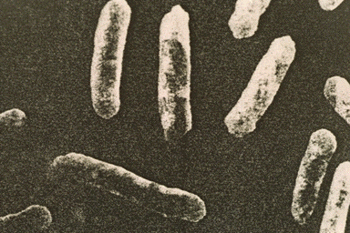Lactobacillus
A Microbial Biorealm page on the genus Lactobacillus

Classification
Higher order taxa:
Bacteria; Firmicutes; Bacilli; Lactobacillales; Lactobacillaceae; Lactobacillus
Species:
Lactobacillus plantarum, L. acidophilus, L. bulgaricusk, L. gasseri
Description and Significance
Lactobacilli produce lactic acid and are used for many different things, including yogurt production and the maintenance of healthy intestinal microflora. Lactobacilli are commonly associated with the gastrointestinal tract of humans. The genome of the Lactobacillus plantarum has been sequenced and the genomes of several other Lactobacilli are underway. The goal of researchers is to better understand the roles, capabilities, and interactions of Lactobacilli.
Genome Structure
The genomes of Lactobacillus plantarum WCFS1, Lactobacillus johnsonii NCC 533, and Lactobacillus acidophilus NCFM have all been completely sequenced, and the genomes of Lactobacillus gasseri, Lactobacillus delbrueckii subsp. bulgaricus ATCC BAA-365, Lactobacillus casei ATCC 334, and Lactobacillus brevis are all in the process of being sequenced. The genome of Lactobacillus plantarum WCFS1 is 3,308,274 bp long with 3,052 open-reading frames, and a G+C content of 44.5%. L. plantarum occupies many different niches in the environment including the human gastrointestinal tract. L. plantarum is very ecologically flexible as is reflected in the fact that it has one of the largest genomes of any of the lactic acid bacteria. The genome of Lactobacillus johnsonii NCC 533 is 1,992,672 base pairs long with 34.6% G+C content and contains six rrn operons at four loci, 79 tRNAs, and two complete prophages. The genome of Lactobacillua acidophilus NCFM is 1,993,564 base pairs long with 34.71% G+C content and 1,864 predicted ORFs.
Cell Structure and Metabolism

Lactobacilli are rod-shaped, Gram-positive, fermentative, organotrophs. They are usually straight, although they can form spiral or coccobacillary forms under certain conditions. They are often found in pairs or chains of varying length. Lactobacilli are classified as lactic acid bacteria, and derive almost all of their energy from the conversion of glucose to lactate during homolactic fermentation. In this process 85-90% of the sugar utilized is converted to lactic acid. They generate ATP by nonoxidative substrate-level phosphorylation.
Ecology
Lactobacilli are commonly associated with plant herbage. They have a generation time ranging from 25 minutes to several hundred minutes, and grow optimally between the temperatures of 30 and 40 degrees Celsius, although thermophilic strains can be comfortable at temperatures as high as 60 degrees Celsius. They are also commonly associated with the gastrointestinal tract of animals and humans. As natural GI microflora they are believed to perform several beneficial roles including immunomodulation, interference with enteric pathogens, and maintenance of healthy intestinal microflora. Lactobacillus gasseri appears to be the main species of lactobacilli that inhabits the human gastrointestinal tract.
Medicine

Lactobacilli, specifically Lactobacillus acidophilus, are considered to have probiotic uses. Research on these claims is controversial and inconclusive. Many people take L. acidophilus to help maintain the pH level of the intestine, through the production of lactic acid, that allows for the proliferation of sensitive yet beneficial microbes that are important parts of the fecal flora, and in doing so can help in replacing useful bacteria in the intestinal tract after heavy antibiotic usage. L. acidophilus also has uses in combating irritable bowel syndrome, hepatic encephalopathy, asthma, high cholesterol, lactose intolerance, and necrotizing enterocolitis. L. acidophilus is also used as a feed additive for livestock, because it supposedly helps the digestibility of food through the production of certain enzymes. New research is delving into the possible use of Lactobacillus acidophilus in combating E. coli colonization of livestock and proliferation of infected meat. University of Nebraska research has shown, in the largest feeding study ever conducted, that calves fed with feed supplemented with L. acidophilus had up to 80% less E. coli in their manure. This is the most promising method in inhibiting E. coli in livestock to date, but further studies need to be done be for it can be implemented on a global scale.
References
Aetna InteliHealth, Complimentary and Alternative Medicine: Lactobacillus acidophilus.
Altermann, Eric, W. Michael Russell, M. Andrea Azcarate-Peril, Rodolphe Barrangou, B. Logan Buck, Olivia McAuliffe, Nicole Souther, Alleson Dobson, Tri Duong, Michael Callanan, Sonja Lick, Alice Hamrick, Raul Cano and Todd R. Klaenhammer.Complete genome sequence of the probiotic lactic acid bacterium Lactobacillus acidophilus NCFM. PNAS March 15, 2005 vol. 102 no. 11 3906-3912.
Lactobacillus acidophilusGenome Project
Microbial Genomics: Lactobacillus gasseri Genome Project
Pridmore, R. David, Bernard Berger, Frank Desiere, David Vilanova, Caroline Barretto, Anne-Cecile Pittet, Marie-Camille Zwahlen, Martine Rouvet, Eric Altermann, Rodolphe Barrangou, Beat Mollet, Annick Mercenier, Todd Klaenhammer, Fabrizio Arigoni and Mark A. Schell. The genome sequence of the probiotic intestinal bacterium Lactobacillus johnsonii NCC 533.PNAS. February 24, 2004 vol. 101 no. 8, 2512-2517.
Ray, Prof. Dr. Sir John Whitman: Twelve Points on Lactobacillus acidophilus
Sonenshein, Abraham L. et al. Bacillus subtilis and Other Gram-positive Bacteria. Washington, D.C.: American Society for Microbiology, 1993.
